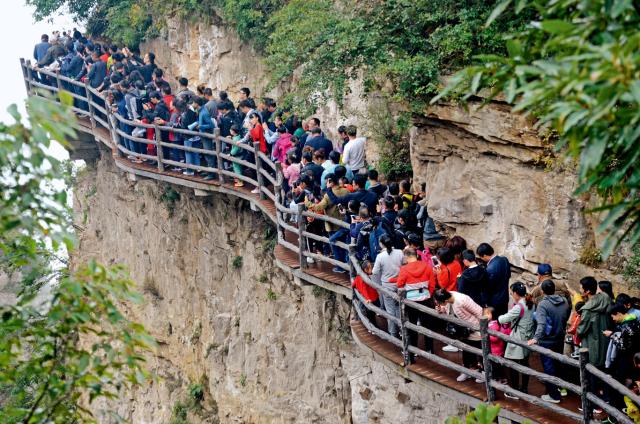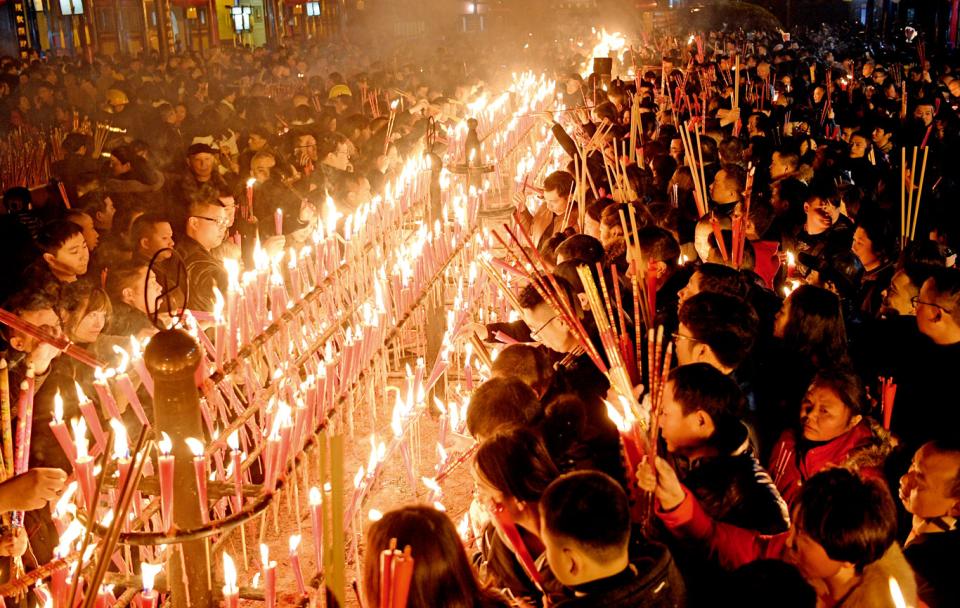Over-commercialization and mismanagement are problems plaguing many tourism spots in China. Will a recent nationwide rectification program help change the situation? NewsChina investigates
As domestic tourism, heavily pushed among China’s drive toward a consumption-led economy, continues to boom, many high-profile sites have been accused of over-commercialization and taking advantage of visitors with high prices and souvenir vendors overrunning historic sites to the detriment of the visitor experience.
Qiao Family Courtyard (Qiaojia Dayuan), a well-preserved cluster of folk houses from the Qing Dynasty (1644-1911) in Qi County, Jinzhong, in northern China’s Shanxi Province, has seen a surge in tourism in recent years. According to official statistics, since November 2014 when it was awarded the title of a 5A tourism spot by China’s Ministry of Culture and Tourism (MCT), it welcomes more than two million tourists every year.
In China, tourism spots are ranked into five levels according to evaluations of its environment, transportation, travel safety, sanitation and other facilities, services and management. In 2019, the ministry conducted a review and inspection of select 5A-level scenic areas, and on July 31, it released a notice warning seven 5A-level tourism spots of serious management problems. Qiao Family Courtyard was slapped with the heaviest penalties and had its 5A status removed. There were strong repercussions among local officials. Both Shanxi provincial Party secretary Luo Huining and provincial governor Lou Yangsheng expressed publicly their dedication to correct the mismanagement situation and vowed to rectify the problems as soon as possible. According to the ministry, there are six major problems with the site’s management, including over-commercialization, lack of sanitation facilities and insufficient resource preservation.
Guo Fengsheng, deputy director for the Qi County Culture and Tourism Bureau, told NewsChina during a recent interview that the county government has reacted swiftly and has laid out 33 detailed measures to tackle the existing problems with a target of getting back its 5A rating within a year.
Cash Cow
Qiao Family Courtyard, the residence for prominent Shanxi merchant Qiao Zhiyong and his family, began construction during the reign of the Qing Dynasty’s Emperor Qianlong in 1756 and was finished in the 18th century. The property covers 9,000 square meters with 313 rooms within six large courtyards and 19 smaller courtyards. In 1986, based on the original architecture of the family courtyard, Qi County government renamed it the Qiao Family Courtyard Folk Culture Museum that features art, science and other things of interest, and opened it up to the public. It became famous after it was used as a location for director Zhang Yimou’s film Raise the Red Lantern (1991), then a TV series named Qiao Family Courtyard. In 2002, it was graded as a 4A-level tourist spot by tourism authorities, and in 2011, it applied for 5A status, which was granted three years later.
China started its tourism ranking system in 1999. If a site attains the desirable 5A rating, it will be widely promoted, meaning more income and more development opportunities for local economies, similar to the economic effects of airports and high-speed railway stations. Welcoming more and more visitors, the Qiao Family Courtyard experienced, like most other Chinese tourist spots, a deluge of visitors and started charging higher admission prices. In 2008, tickets to the complex cost 40 yuan (US$5.6), but by 2019, it had increased almost four-fold, to 138 yuan (US$19.35). In 2016, it received over two million visitors with admission fees totaling 103.16 million yuan (US$14.5m), its records show.
Overly profit-driven is the general impression most visitors got when visiting the place in recent years. One tourist told NewsChina: “I spent 138 yuan (US$19.35) on the ticket, but it didn’t feel like I was visiting a historical site. It was more like experiencing an open bazaar, with peddlers everywhere selling nondescript products.”
NewsChina obtained an official document from Qi County which states that market stalls occupy most of the public space without effective regulations. The document says that at the exit, there is a street where local villagers can set up their own small businesses selling local food or handicrafts. One local villager from Qiaojiapu Village told the reporter that the market was set up in 1988 and each villager could get an average of 0.5 square meters. If anyone wants more space, they can rent from other villagers. So far there are around 100 stalls. This villager expressed during the interview that these small businesses have been the main source of income for local villagers for many years. “For example, take the [October 1] National Day holidays, each stall can make an average profit of 10,000 yuan (US$1,403).” An official from Qiao Family Courtyard Tourism Management Center told NewsChina that although the market does successfully provide income for local villagers, it is not well-regulated and some vendors have “mischievous activities” that have damaged the overall image of the historical site. According to Shao Qi, deputy director of the Shanxi Provincial Tourism Quality Evaluation Committee, the merchant culture in Shanxi has been cultivated as a unique local brand, and the recent deprivation of the 5A status has had a negative impact which will result in fewer visitors and lower incomes for villagers and local tourism.
Mismanagement
A senior official, who spoke on condition of anonymity, from the Jinzhong City government told our reporter that initially there were six supervision agencies in charge of the operation of the Qiao Family Courtyard, including Qi County Culture and Tourism Bureau, Qiao Family Courtyard Tourism Management Department, Shanxi Qiao Family Courtyard Tourism Company and Qiao Family Courtyard Folk Culture Museum. He said that different agencies were in charge of operations for different areas. For example, one handled the market at the exit, and another was for management of some of the interior courtyards and the garden.
This messy network of management resulted in ambiguity in clarifying responsibility and power among different stakeholders. Thus in June 2007, Qi County Yuanda Investment Company was set up to represent the county government and be responsible for overall operations. In December 2007, this new company again cooperated with two other companies from Shanghai and Chongqing to set up a joint venture which was granted the right to operate the site for 20 years. According to a contract between the local government and the company, the company will retain all the admission fees in exchange for an annual levy of 100 million yuan (US$14m) to the Qi County government for cultural relic management fees.
However, due to a potential violation of China’s Law on the Protection of Cultural Relics, the National Cultural Heritage Administration and Shanxi Provincial Cultural Heritage Bureau called off the deal. In 2008, Qi County State-owned Assets Supervision and Administration Commission set up a State-owned company to invest and operate part of the tourism project.
“In the decade after the failure of the reform attempted in 2007, to purely depend on investment from the government is not sufficient to effectively operate the tourism site,” said Wu Wensheng, Qi County Party secretary. “Lack of capital and lack of marketing capacity forced us to again attract outside investment.” After another attempt in 2016, Jingshi Henghua, a Shanxi-based firm, spent 522 million yuan (US$73m) to get overall control of the project. Subsequently, according to a news report by China News Agency in September 2017, private capital started to shoulder all the cost of operations, marketing and advertising, which saved the local authority 220 million yuan (US$30.8m).
After the Qiao Family Courtyard was penalized, it shut down for 10 days in August to enact some improvements. The price of an adult ticket was cut to 115 yuan ($16.22), although most visitors still think it is too much. During a recent visit, the reporter observed that only a limited number of shops selling related cultural heritage products were allowed to operate.
Liu Xuechang from the management department of the Qiao Family Courtyard told NewsChina that 29 stores were closed and 1,050 square meters were reserved for future exhibitions on merchant culture. The original shopping street at the exit and all advertisement boards were dismantled. Other measures, according to another senior official from the management center, included increasing car parking spots, installing other facilities including wheelchairs, baby strollers and mobile phone charging stations as well as information touch screens. Some tourists told the reporter they thought the changes were positive.

Mount Yutai, a popular tourist spot in Henan Province, October 6, 2017
Prevalent Issue
There are 250 5A-rated tourist sites among around 30,000 tourism spots in China. The other six 5A locations warned by the ministry also had to carry out improvement programs.
For example, Mount Emei in Sichuan Province, one of the six on the blacklist, was accused of selling expensive incense and overcharging people for photography permits.
Earlier ministry inspections found infractions at high-profile sites, including Wutai Mountain in Shanxi, the Ming Tombs in Beijing, the Confucius Temple in Nanjing, Jiangsu Province and Qiandao Lake in Zhejiang Province. The heavily touristed and commercialized town of Lijiang in Southwest China’s Yunnan Province was also warned by the ministry. From 2015 to 2017, 19 5A tourism spots in China received warnings.
Similar to the previous problems at some UNESCO World Heritage sites, once a tourist site gains recognition, tourists flood in and the site struggles to deal with the influx. Media reported that tourist arrivals in Pingyao, an ancient walled city in Shanxi Province which was added to the UNESCO list in 1997, increased by 300 percent in 1998.
In 2007, six World Heritage sites in China received warnings from UNESCO about possible removal from the list, which included Lijiang and the Three Parallel Rivers National Park, an area containing the upper reaches of three great Asian Rivers, the Yangtze, Lancang (Mekong) and Nu (Salween) River, also in Yunnan. In Beijing, the Summer Palace, the Palace Museum (Forbidden City) and the Temple of Heaven were warned, as well as the Potala Palace in Lhasa, Tibet Autonomous Region. One of the major reasons was tourism pressure. As a result, some cultural heritage experts pointed out at the time that the honor of being chosen as a UNESCO cultural heritage site could be more detrimental than beneficial to some heritage sites if it is not managed well.
After the recent round of ministry inspections and penalties, local governments at both provincial and city levels started to take action. “The competition among different tourism sites began to shift from the actual tourism resource to products and service quality, and will turn into brand competition,” Shao Qi told NewsChina: “5A level tourism spots are representatives of the highest tourism destinations with unique and rare resources and they possess an extraordinary brand effect.”
Referring to the future development of the Qiao Family Courtyard, Shao pointed out the urgent need for it to invite experts in setting up standardization and self-monitoring systems, while offering more capacity building programs for staff on how to promote cultural tourism, so as to maintain the service quality and facility operations to meet the 5A standard.
Wang Xingbin, former director of the Tourism Science Institute at Beijing International Studies University, told NewsChina that fully reviving tourism potential at the Qiao Family Courtyard requires it to bring back traditional Shanxi merchant culture, which values honesty and loyalty, into its operation system.
“They have to rectify the management and the way they operate to create a mutually beneficial platform for the government, enterprise and local communities. If they can do this, the Qiao Family Courtyard can expand and upgrade their model of tourism from a single cultural heritage site to one which encompasses regional village tourism and leisure travel,” Wang said.
“It could even provide a model for other places to follow in the future.”

 Old Version
Old Version
